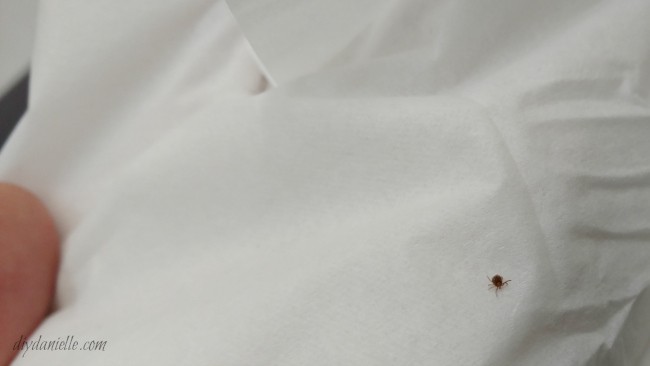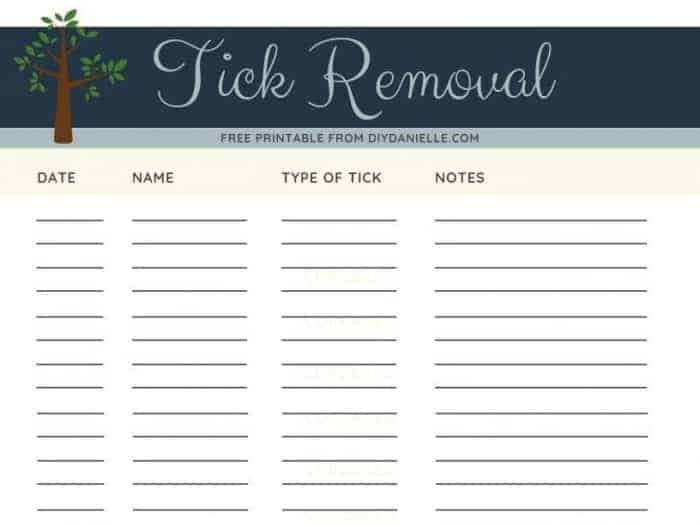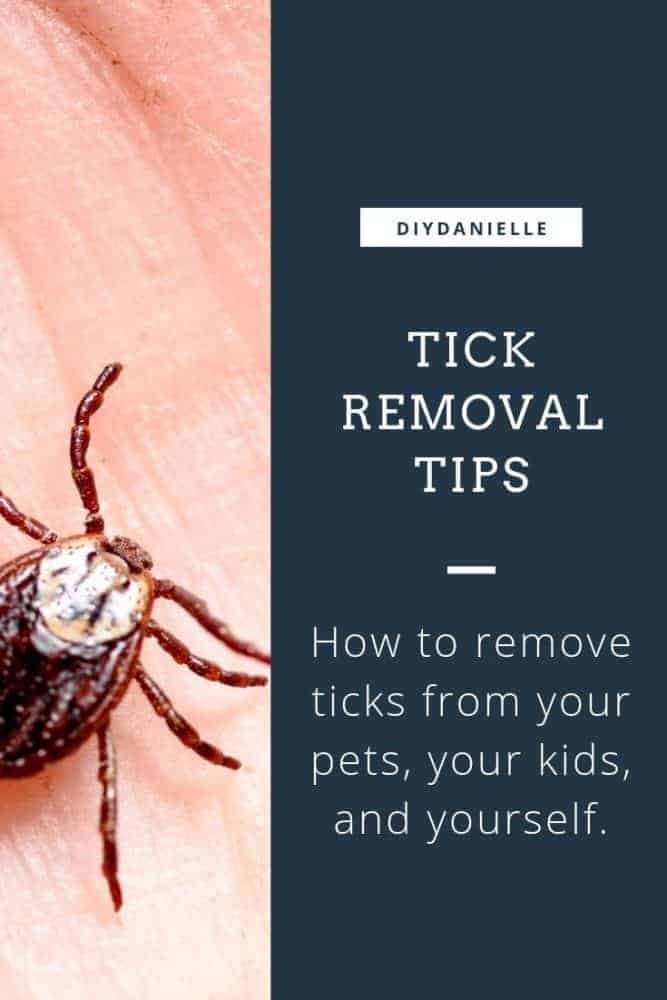
How to remove a tick from your dog, your child, or yourself. Tips for safely removing ticks, testing ticks for Lyme disease, and how to prevent tick bites.
This post may contain affiliate links which may earn me commissions should you click through them and take certain actions. As an affiliate for Amazon, Cricut, xTool, Home Depot, and other sites, I earn from qualifying purchases. Please DIY carefully. View my full legal disclosures here.
Please read the whole post so you don’t miss any important information!
Disclosure: I am not a doctor. I am not a pest control specialist. Please consult with the necessary professionals for more information on any of these topics. My goal is to give you an overall look at tick bite prevention and treatment.
We love to spend our summer days playing in the woods, throwing a ball to the dog, riding horses, playing baseball and more. While we make every attempt to landscape to prevent ticks, the reality is that we expect to find a few ticks each year. We do daily tick checks, we use tick prevention for our dog, and we remove ticks as soon as we find them.
The best way to prevent Lyme disease?
Prevent the ticks from attaching.
This can be done by using bug repellent, by taking showers and putting clothes in the laundry immediately upon coming inside, and by doing daily tick checks.
The second best way?
Remove ticks ASAP, preferably within 24 hours.
It takes time for the ticks to spread disease to their host. The sooner they’re removed, the safer you are from catching something.
Again, daily tick checks are vital.
You NEED to be able to safely remove ticks before they spread disease to yourself, your pets, or your family.
Today we are going to talk about how to remove ticks.
The Bullet Point Tips for Tick Removal
If the tick is loose:
If you find a tick loose on your body, wandering around looking for a spot to bite, take a piece of tape and get the tick off your skin with it. Fold the tape over the tick. You don’t need or want to squeeze it. Just let it die a slow death.
If the tick is attached:
- Stay calm
- Get tweezers
- Grasp the tick firmly with the tick and pull straight out slowly, being careful to remove the whole tick including the embedded head.
- Dispose of the tick carefully
- Don’t squish the tick or attempt to use chemicals or fire to burn it.
- Use a piece of tape to dispose of the tick or, if you don’t have that, use a container with some alcohol in it. Make sure to close the top so it can’t climb and escape. We like empty baby proof medicine containers. Label the container.
I’m going to get into the specifics of removing ticks from dogs and children because I find them to be slightly more difficult to remove ticks from than an adult.
Tick Removal Tools
- Tweezers (I keep a pair exclusively used for ticks). I did try the tick twister, but I’m hesitant to use it. From the CDC’s recommendations, they want you to pull the tick out straight and not twist it in any way.
- Something to Dispose of the Tick
- Empty pill bottle with some rubbing alcohol. Label it carefully and put it out of the way (or toss).
- Tape: Alternatively, you can completely cover the tick with tape and make sure it doesn’t escape.
How to Remove a Tick from a Dog
Checking for Ticks on Your Dog
You can check for ticks on your dog by running your hands all over his or her body. Usually you can find ticks by just petting your pet normally, but it’s important to check everywhere.
Around the ears, mouth, and legs are all places I’ve found ticks. Once we found a tick on (wince) my dog’s butt. He was very offended about the whole removal process.
When you’re searching, you feel around for any bumps. If you feel one, you part the fur in that area and look to see if it’s a tick.
Ticks can be very small or they can be large and easy to find.
Removing Ticks from a Dog
When you’re dealing with ticks, it’s important to remain calm. This is particularly important when removing them from a dog because pets are excellent at picking up on our emotions. You want your dog to remain calm.
If you’re struggling to remain calm, remember that most ticks don’t spread disease and while they’re gross, they are just another bug. It’s part of having a pet to be able to calmly do tick checks and tick removal.
It is always useful to have a second person to help hold the dog. This keeps the dog from moving while you’re removing the tick. You need to be able to remove the tick without losing the head or squishing the tick.
If I have a helper, I have them grasp the animal from the other side of their body, holding them around the neck and jaw, as well as their butt. Please be careful if your dog bites. You may need to use a muzzle, but I’ve never had a dog prone to doing this so I’m not experienced with that.
I have found that dogs get very nervous when you try to come at them with tweezers to remove something they can’t see.
When I’m working alone, I do my best to hold the dog so he won’t move. Sometimes you can get a calmer pet to sit still by offering them a special treat like peanut butter or a Kong filled with treats to work on while you work.
The important piece is that you need to work fast. Find the tick, part the fur, and then use tweezers to grasp the tick firmly. Do NOT squeeze the tick or burn it or attempt to use chemicals. Pull the tick straight out with the tweezers, being careful not to lose the embedded head.
You can use alcohol to clean the area and dispose of the tick in a piece of tape or a container of rubbing alcohol. Make sure the container has a top so the tick can’t escape. It takes them quite some time to die.
How to Remove a Tick from a Child
Checking for Ticks on Your Child
Check all areas of your child’s body, preferably after their shower or bath. It’s easier than trying to work around clothing.
Make sure to check their hair thoroughly. Check behind ears as well.
Kids are easier to tick check than pets, simply because their hair is contained to their head. We usually have the kids do a slow spin for us after their showers for the body check, then do a check of their hair.
Removing Ticks on Your Child
Removing ticks from children is very similar to removing them from a dog or other pet. They are also extremely adept at picking up on emotions so stay calm. Talk to them. Use a nice steady hand to remove them so you don’t leave parts of the tick in the wound.
Don’t make this a traumatic event for your child. Dogs forget, but kids will forever remember their last tick removal. Make it a relatively positive experience and the next time you have to remove a tick, they will be EASIER to deal with.
I have two sons and like many young kids, they don’t love bugs that bite. Bees. Mosquitoes. Ticks. My 3 year old recently had a tick and I made sure to calmly talk him through the whole removal process. I find talking helps keep me calm so I explained why we need to remove ticks, what they are, and how they can sometimes spread bad diseases.
I explained the removal process while I was doing it and how it wouldn’t hurt him, just the tick. Then we put the tick in some alcohol and checked out what the tick looked like.
This all happened at 2 am or thereabouts.
We disposed of the tick, I checked my son all over for other ticks then put him back to bed, then I went to take a shower because ticks freak me out and I needed to feel clean again and I needed a private place to have my delayed freak out. Haha. Shhh don’t tell the kids.
Removal is the same process- part any hair at the location, grasp the tick with the tweezers WITHOUT squeezing it, pull straight out. Don’t lose the head. Usually it comes out with the body if everyone is calm and hands are steady.
After Care for Tick Bites
Wash the tick bite area with soap and water. I follow up by washing the area with rubbing alcohol. I do the same with my hands and tweezers. And anything that the tick might have touched.
If you have one tick, it’s always good to do a in-depth check for others.
It might be worth tracking tick bites, particularly if you get a lot of them. Be on the look out for symptoms of Lyme disease (such as rash or fever) or other tick related diseases. If you get symptoms within a few weeks of the bite, inform your doctor and they will run tests.
Using Chemicals or Fire to Remove Ticks
Don’t use chemicals or fire to encourage ticks to back out. You’re just exposing yourself, your child (or other person), or pet to chemicals or fire that could further injure them.
You’re also delaying how quickly the ticks are removed. Time is of the essence so you can remove the tick before any disease is transmitted to you, your child, or your pet.
Should Ticks be Tested?
According to the CDC website, it’s not necessary to test ticks. It’s much more accurate to get tested yourself if you show symptoms of a tick related illness. This is because the tick usually needs to be attached for a while to spread Lyme or other illnesses. It’s also potentially faster to just get tested yourself.
That said, some people do keep ticks for a few weeks until they’re sure they don’t have any symptoms. If so, keeping them in a container with rubbing alcohol is good. My mom always used empty pill bottles with alcohol for this.

Preventing Tick Bites
If you go for a walk somewhere that might have ticks, make sure to dress appropriately. Long pants and sleeves help, particularly if you’re careful to remove them after you get home and launder them.
Have a friend or family member check you for ticks after. This is easier said than done because so many people go into panic mode about ticks. I am the tick pro in our house… I don’t trust my husband to be as careful about checking for them. I’ve met so many people whose squeamishness or disinterest makes them poor tick hunters. Don’t be a poor tick hunter. Be diligent.
Personally I shower within 2 hours after I may have been exposed to ticks. A shower will not remove an attached tick, but it can remove one that is wandering and looking for a place to bite.
I also toss my “woods clothes” into the laundry. The CDC says that tossing the clothes in a dryer on high heat for 10 minutes can get rid of them, but I completely launder the outfit because usually I’m not rewearing my outdoors clothes like that.
Chemicals to Prevent Ticks
I’m very hesitant to try chemicals so I tend to avoid them when I can. But I did some research for you and it appears that DEET bug spray is not as useful at preventing ticks as another chemical, permethrin.
Unfortunately, it doesn’t appear that the chemical permethrin is safe to put directly on your skin so you need to treat your clothing instead. You can also make tick tubes or landscape your yard to help decrease the tick population in your yard
Visit the CDC Website on How to Avoid Tick Contact for People to see how you can treat your clothing to prevent ticks.
Free Tick Bite Tracking Sheet
I went back and forth about whether this would be a useful tool for some of you. I’m hoping nobody gets ticks this often!
But in case you do, I created a free tick bite tracking sheet to keep track of tick bites for your family.
The FREE printable tick bite tracking sheet is available by clicking Tick-Removal-Tracker download below.
Here’s a short version of the tracker so you can get an idea of what the tracking sheet looks like. You could certainly just write it down in your family notebook too.

Other Posts about Dealing with Ticks
Here are the other posts in the tick series:
- Preventing Ticks in Your Yard
- What are Ticks, What Diseases Do They Spread, and Should You Be Worried?
Please share and pin this post!

